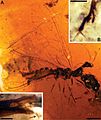Snakefly facts for kids
Quick facts for kids SnakeflyTemporal range: Lower Jurassic – Recent
|
|
|---|---|
 |
|
| Female Dichrostigma flavipes | |
| Scientific classification | |
| Kingdom: | |
| Phylum: | |
| Class: | |
| Infraclass: | |
| Order: |
Raphidioptera
Handlirsch, 1908
|
| Synonyms | |
|
|
The Snakeflies (also called Raphidioptera) are a small group of insects. They are related to other insects like Megaloptera and Neuroptera. There are about 210 different kinds, or species, of snakeflies alive today.
Snakeflies are easy to spot because of their unique look. They have a small head and a long 'neck'. This 'neck' is actually a part of their body called the prothorax, which is much longer than usual.
An adult snakefly is usually about 15 millimeters (0.6 inches) long. They have two pairs of wings that look similar and have many veins, like a net. They also have long antennae and mouthparts for chewing. Female snakeflies use a special tube called an ovipositor to lay their eggs.
Life Cycle
Snakeflies go through a complete life cycle. This means they change a lot as they grow, from an egg to a larva, then a pupa, and finally an adult.
The larvae of snakeflies are very active. They are also carnivorous, meaning they eat other insects. These larvae often live under loose tree bark, where they can find food.
You can find snakeflies on every continent except Australia. They are helpful to humans because they eat the larvae and pupae of other insects. This helps control insect populations that might be pests.
Images for kids
-
Juroraphidia longicollum (†Juroraphidiidae) a transitional fossil from the Middle Jurassic of China
-
Amarantoraphidia (†Mesoraphidiidae) found in Early Cretaceous amber from Spain
-
Ohmella coffini (Raphidiidae) from the Miocene of France
See also
 In Spanish: Rafidiópteros para niños
In Spanish: Rafidiópteros para niños






